Xamarin Interview Questions and Answers
1) What is Xamarin?
Xamarin is a company that builds the software. The main operation of Xamarin is to build mobile apps that work on cross-platforms. It is used to build the UI for Android, iOS, and Windows operating system. Xamarin application shares the codebase. Xamarin's feature is similar to the native application. A developer can download the Xamarin tools in Visual Studio.
2) What is the advantage of Xamarin Development?
Benefits of Xamarin Development are:
- The user interface is simple and native.
- Developers can use Xamarin to make cross-platform apps.
- The chances of the bugs are less.
- We can create an app for iOS, Android, and Windows using the same codebase.
- Xamarin has powerful community support.
3) What are the disadvantages of Xamarin Development?
Disadvantages of Xamarin app Development are:
- The development of user interfaces in Xamarin is Time-Consuming.
- The apps created in Xamarin have a large file size. These apps are mostly between the 3 MB to 15 MB in size in the store.
- Even apps share the code across the platform, but there is also a need for the developer to create the linkage in the OS, which is difficult for the user.
4) What are the development approaches in Xamarin?
Xamarin has two approaches for app development. These are
- Xamarin.Forms: Forms are the choices for the developers who want to create one application for all the separate mobile platforms, which are Windows, iOS, and Android.
- Xamarin Native: This approach is used in those scenarios when we want to create a separate version of the same App for different platforms. Developers can use Xamarin.iOS, Xamarin.Android and Xamarin.Windows libraries to create the applications for each particular platform.
5) What are the differences between the Xamarin and Xamarin.Forms?
The differences between the Xamarin and Xamarin.Forms are:
| Xamarin | Xamarin.Forms |
|---|---|
| Xamarin is an app development tool to create cross-platform mobile applications. | Xamarin.Forms is a UI toolkit to develop the application. |
| Developers can use Xamarin.iOS, Xamarin.Android and Xamarin.Windows to create the application which is based on the particular platform for which the apps are created. | Developers can use Xamarin. Forms to create the one native version of the App which can run the entire mobile platform. |
6) What is Xamarin Profiler?
Xamarin Profiler is a tool which is used by the developers to keep an eye on the information about the particular App inside the Visual Studio. With the help of Xamarin Profiler, developers can easily analyze the App's behavior. We can use the profiler to track the application's memory information and can sample its statistics.
7) What is Xamarin Insights?
Xamarin insight is a tool that allowed the developers to identify and track the issue with the apps in real-time. We can also use this for the monitoring system to report the problems. Xamarin introduced Xamarin Insight in October 2014. However, it was closed on March 31, 2016. In today's time, developers can believe in Visual Studio App Center for the same functionality that is provided by the Xamarin Insights.
8) What is Xamarin.Forms?
Xamarin.Forms is a framework which is used to build the user interface in the mobile application. In the same codebase, developers have to write the UI separately for each platform. This is time consuming and difficult process. Xamarin.Forms allows the developer to create just one UI which can be used across all platforms like Android, iOS, and Windows.
9) Which programming language supports the Xamarin?
Xamarin supports three languages in the development of mobile applications:
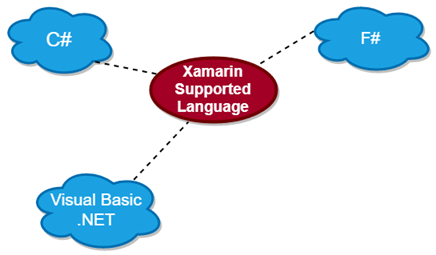
- C#
- F#
- Visual Basic.NET
10) What is the role of XAML in Xamarin?
XAML or Extensible Markup Language is a special tool that allows the developer to define the user interface in Xamarin app development. XAML has a vital role in Xamarin, but it is not necessary for app development in Xamarin.Forms. Xaml works with ModelView-ViewModel or MVVM architecture of an application.

11) What is Xamarin Studio?
Xamarin Studio is a standalone IDE for developing the cross-platform mobile application, which is based on the open-source project Monodevelop.
12) What are the differences between the Xamarin Studio and Visual Studio?
Both Xamarin Studio and Visual Studio are IDEs used to develop the Android, iOS, Class Library, Console, PCL, and Windows Phone application. Both Xamarin Studio and Visual Studio support F#.
| Xamarin Studio | Visual Studio |
|---|---|
| Xamarin Studio works on both Windows OS X environments. | Visual Studio is available only for the windows environment. |
| On Windows, Xamarin Studio doesn't support windows phone and iOS project. | In Visual Studio, we can create any app. |
| Xamarin Studio on Windows supports only Xamarin.Android project. | Visual Studio supports Xamarin.Android, Xamarin.iOS, and Xamarin.Windows project. |
13) What is the lifecycle of Xamarin.Forms apps?
Xamarin.Forms is a platform to develop the cross-platform mobile applications by using the XAML for Front-End and C# for the backend of the application. In Xamarin.Forms application, we can share all code. Xamarin.Forms also give the 100% API coverage of Android and iOS native APIs. So that, we can develop native Android, iOS, and Windows apps.
For more information about the LifeCycle of the Xamarin.
When we create Xamarin.Forms application we will see four projects:
- Portable Project: This is the project where we will write 95% of our application code, and this code is shared in all the three platforms.
- Android: This is the project where we set the Android application icon and splash screen, and all the other code will come from the portable project.
- iOS: In this project, we set the iOS application architecture and icon.
- Universal Windows: Universal Windows Platform is the application platform
14) What are the types of data binding modes in Xamarin?
The different types of data binding modes are:
- Default
- One way: changes in the source affect the target
- Two way: Changes in the source and destination affect each other
15) What is the difference between the Xamarin and Mono?
| Xamarin | Mono |
|---|---|
| Xamarin is a powerful solution for building awesome apps. | Mono is used in those cases when we want to build an app for a single platform. In that case, there is a need for a Native platform. |
| With the help of Xamarin, we can create Native apps for multiple platforms via the same IDE, APIs, and Language. | Native mobile apps are built on Android, iOS.Java, and Windows. |
| Using Xamarin, we can skip the extra development time for each platform. | Using Mono, we cannot skip the extra development time for each platform. |
| Xamarin apps are accessible for more comprehensive ranges at a lower cost. | Mono apps are accessible for the broader ranges at a higher cost. |
16) What are the different scenarios used in Xamarin.Forms?
The following are the different types of scenarios that are used in Xamarin.Forms:
- View to View binding
- Backward binding
- Binding with the models
- Binding with the collections
17) What is data binding in Xamarin?
Data Binding is a technique that is used to synchronize the source of the data with the user interface. When the data binding is done and the data or our business model changes, then it shows the changes automatically to the UI elements and vice versa.
18) What is the Xamarin test cloud?
The Xamarin test cloud allows us to test the mobile application on various devices. The Test cloud is also used for automated testing in many real devices simultaneously.
19) How to set up the Xamarin?
For Xamarin set up, there are four steps:
- Download the Xamarin Installer
- Run the installer
- Configure it
- Activation of Xamarin
For more information click here: Installation of Xamarin
20) What are the types of layout control in the Xamarin.Forms?
Different types of layout control in Xamarin.Forms are:
- Stack Layout
- ContentView
- Frame
- ScrollView
- TemplateView
- Absolute Layout
- Grid
- Relative Layout
For more information about layout XamarinLayout
21) What are the different kinds of Pages present in the Xamarin.Forms?
The different types of pages present in the Xamarin.Forms are:
- Content page- This type of page displays a single view, often a container such as a stack layout or the scroll view.
- MasterDetail page- MasterDetailPage is a page that manages the information between the two related pages.
- Navigation Page- Navigation page manages the navigation of the pages.
- Tabbed Page- Tabbed Page helps the navigation of the children page using the tab.
- Template Page- The Template page helps to display the content of the full page with a control template.
- Carousal Page- This page allows the swipe gesture between the subpages, such as a gallery.
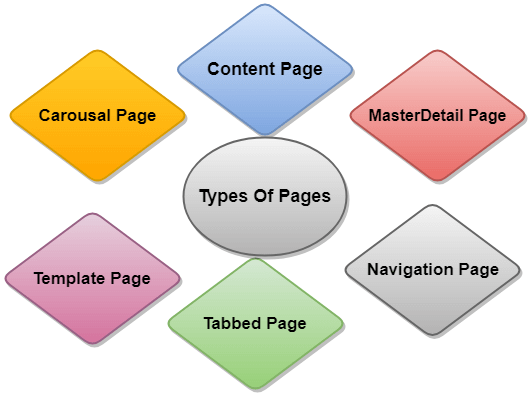
For more information about the Xamarin Page Xamarin.
22) What are the advantages of Xamarin?
Benefits of Xamarin are:
- We can deliver the native iOS, Android, and Windows app using the existing skills, and code (C#, XAML).
- We can take full advantage of Native APIs with Xamarin Technology.
- Xamarin Component Store allows us to add the high-quality components to our App directly from IDE, including controls, web service APIs, and more.
- PCL/shared project makes the development easy for developers to share the same code base across different projects.
23) What are the code-sharing techniques in Xamarin.Forms?
There are two methods of sharing the code between the cross-platform applications:
- Portable Libraries (PCL)
- Shared Projects
The goal of the code-sharing strategy is to support the architecture where multiple platforms can utilize a single code base.
24) What is the difference between the portable class library and shared projects?
Portable Class Library
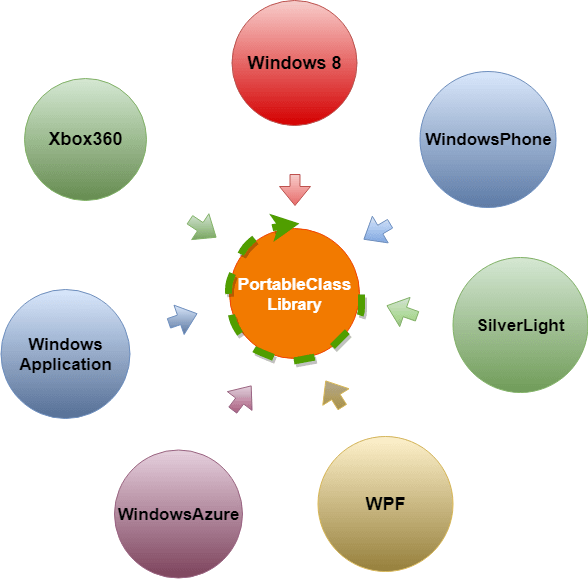
We create Class Library in .Net to reuse our code or to make our code reusable with the same type of application only, but that might not work for some conditions. Here we assume, we have created the class library for WPF or any other kind of application. And if we want to access the same type of class library for Windows 8 or Windows phone application, then in this scenario, we can't refer this as a class library.
We want the same application for all the platforms to make our life easy. We want the same application used on multiple platforms. Microsoft technology is growing day by day, and it covers every device. All types of applications we can build and validate within one framework on all types of platform Windows, Web, Mobile, or Tab.
PCL solves this problem. .Net 4.5 introduced the Portable Class Library (PCL) for developing the business logic in one location, and we can use this library end to end in all types of applications or all platforms (Windows, web, or Mobile) on .Net Framework.
The figure shows the flow of the Portable Class Library (PCL). All these applications run on the .Net Framework. All these applications have different environments and platforms, but they all can easily use the Portable Class Library. In other words, we can say that we only need to prepare the UI and do the DataBinding of our application for all the windows, web and mobile, because the same business logic can then use the entire platform.
Shared Project
A shared project is a project that contains standard code and linked to each specific platform library or App. It is compiled as a part of the platform-specific code. To develop a nice solution that is based on a shared project, there is a need to architect it to have the core features in the shared project. Here possibly, we may use partial classes, abstract classes, and interfaces to manage the objects which are specific for each platform in the platform-specific project. These kinds of projects are good when we are in a prototype phase because it is fast to implement the shareable project for the common code. We can use all the advantages of the platform-specific Framework.
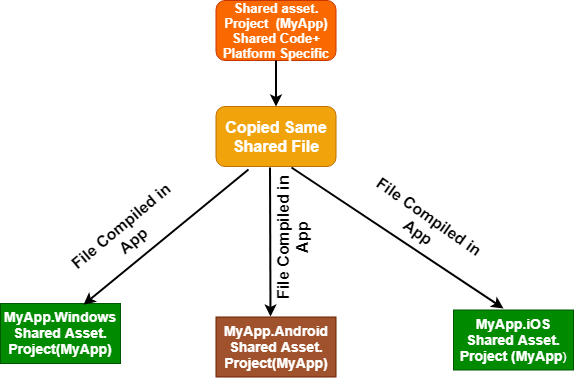
Shared Code can be branched base on the platform using compiler directive (e.g. #if_Android_,#if_iOS_,#if_Windows_Phone_App.etc.)
- No output assembly
- Refactoring operations, not update automatically.
25) What are the advantages of XAML?
The advantages of XAML are:
- XAML gives a clean division of the application and its code. Thus, it enables a clear developer-design flow.
- XAML is more crisp and precise than a similar code.
- XAML has the parent-child hierarchy of user-interface objects with greater visual interface simplicity
26) What are the Views?
Views are known as control of widgets. They can be visual objects such as Label, Button, Entry, BoxView, ListView, TableView, etc. All the UI elements are the sub-classes of view.
27) What is the difference between ListView And TableView?
ListView and TableView controls are similar. We can take them as a single control. The major difference between them is how they layout the items.
ListView: ListView control displays the stacks of data vertically. It is just like a standard Listbox. We use this control to display the order of data in the list, especially the long list, that requires scrolling, like a list of email messages, a list of contacts, or search results.
TableView: TableView displays the stacks of data horizontally in rows. We use this control when we need more space for rich visualization of the item to be displayed.
28) What are the types of the App which use Xamarin?
The different types of apps which use the Xamarin are:
- OLO- an online platform to order food.
- The World Bank survey app- This App is used for the global survey.
- Storyo- This App helps to create videos from the picture.
- Freshdirect- This App is our friendly grocer.
- Just Giving- a philanthropic interface.
29) What are the different types of scenario used in Xamarin.Forms?
The scenario used by the Xamarin.Forms are:
- View to view binding
- Backward bindings
- Binding with the collections
- Binding with the models
30) What are the apps designed by Xamarin for Android?
The apps designed by Xamarin for Android are:
- The secret society
- Parental Access
- Toolwiz cleaner
- iLearnForKids
- Goal 2014 Football manager
31) Name the apps that were designed by Xamarin for iOS?
The apps that were designed by Xamarin for iOS are:
- QuickPLan- Project Plan HD
- NewsPager
- Apocalyspe Archer: Zombie invasion
- Stone Skimmer: Skimming action game
32) How Xamarin.Android applications work?
Xamarin.Android applications depend on Microsoft's Mono Virtual Machine. Mono is Microsoft's open-source implementation of the .Net Framework, which is based on open source standards of C# and CLR. Mono was launched in the year 2001. It was created to allow the .Net applications to work on the Linux platform, but was later modified to support the development on various devices, including embedded systems.
In Xamarin, Mono works in parallel with Android's ART. On Android, most of the system facilities like Audio, Graphics, OpenGL, and Telephony are not available directly to the native applications. They can be added through the Android Runtime Java APIs, which is available in one of the Java.*namespaces or the Android.*namespaces. The native applications then interact with the exposed .NET APIs. These APIs then, through the Android Binding, call the Android runtime Java APIs.
The architecture looks like this:

33) What is Fresh MVVM?
Fresh MVVM is a super light MVVM framework which is designed specifically for Xamarin.Forms only. Its design is easy, simple, and flexible. It is easy to learn and uses the convention over configuration.
Fresh MVVM is a little different from MVVM. FreshMvvm uses the concept of Page and PageModel instead of View and ViewModel.
34) What is the difference between the MVVM Cross and MVVM Light?
MVVM Cross: MVVM Cross is a .NET cross-platform MVVM framework. It allows us to make a cross-platform solution for platforms such as Xamarin. Forms, Xamarin.Android, Xamarin.iOS, Xamarin.Mac and WPF. It is an inactive state of development.
MVVM Cross requires the application to be divided into two parts: Core and the UI.
The Core part contains the View Models, Service, Models, and the Business logic, whereas the UI part consists of the different views and platform-specific code that interact with the core. The views are the View Screens, which contain the graphical content. In addition to Core and UI, the application may contain additional libraries for various functionalities.
Features that are provided by MVVM Cross are:
- An MVVM architecture pattern
- A flexible Navigation system
- Data binding to allow automatic binding with the source to target.
- Platform-specific support
- Inversion of Control Container
- Dependency Injection engine
Consequences of MVVM Cross are:
It has an excessive learning curve and lacks a Wiki for how to get started developing the apps.
MVVM Light: MVVM Light is another Framework that allows the creation of Enterprise-Grade apps using the MVVM Architectural pattern on Xamarin. MVVM Light enables the developer to create and develop MVVM applications on a variety of platforms like Xamarin. Forms, Xamarin.Android, Xamarin.iOS, UWP, and WPF. It allows us to separate the View from Model and hence write the testable and extensible applications. It does not support async.
MVVM Light application is divided into the following parts:
- View: It is a platform-specific user interface which is associated with the screen.
- ViewModel: It exposes the data and related properties of the data.
- ViewModel Locator: It registers custom ViewModels.
35) What is the need of the Model-View-ViewModel (MVVM ) pattern in Xamarin?
The Model-View-ViewModel can be used on all platforms. It intends to provide a clean separation between the user interface controls and their logic.
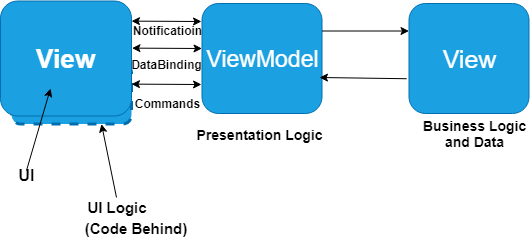
Benefits:
- During the development process, developers and designers can work independently on their components. Designers can concentrate on the view, and if they are using Expression Blend, they can generate sample data. On the other hand, developers can work on the view model and model components.
- Developers create the unit tests for the view model and can create the model for the view.
- It is easy to redesign the UI of the application without touching the code because the view is implemented entirely in XAML. A new version of the view should work with the existing view model.
- If there is any existing representation of the model that binds the existing business logic, this can be difficult or risky to change. In this scenario, the view model acts as an adapter for the model classes and enable us to avoid making any major changes to the code of the model.
36) What is NuGet and how this can be useful in App development?
NuGet is the most popular package manager for the development in .Net. It is present in Xamarin Studio 5 and Visual Studio. We can easily search and add package/third party libraries to the Xamarin.Forms using IDE.
37) What is the HTTP client?
HTTPClient helps the developers to connect with the external world through the internet using the REST-based services. HTTPClient class is used for sending the HTTP requests and receiving HTTP response from a resource, which is identified by URI. HTTPClient class present in System.Net.HTTP namespace.
38) What is ResourceDictionary?
ResourceDictionary is used to define the XAML Resources, which can be reused more than once throughout the Xamarin.Forms application.
- Xaml Resources are the definition of objects which can be used more than once.
- ResourceDictionary allows all the resource objects declared at one place.
- We can define Styles, ControlTemplates, DataTemplates, Colors, and Converters into the ResourceDictionary.
- In XAML, resources can be accessed at the Element level (inside specific element), Page (inside page) level or Application Level (inside App.Xaml).
39) What is the difference between Xamarin. Forms and Xamarin Native?
Xamarin.Forms :
Xamarin.Forms are used when:
- the requirement of the code is less in the platform-specific scenario.
- Code-sharing is more important than custom UI.
- The UI is not complex.
Xamarin Native:
Xamarin Native is used when:
- a lot of platform-specific code is required.
- Custom UI is more important than code sharing.
- When platform-specific APIs are used.
40) What is the App.cs class?
App.cs is the main class of the App which offers features like:
MainPage: It helps us to set the initial page of the App.
Properties Dictionary: It helps us to store the values across the state of the lifecycle.
Static Current Property: It gives the instance of the current application object
41) What is the lifecycle method of the Xamarin.Forms App?
Lifecycle methods are the set of techniques which are executed when the application enters into a specific state. The ways are:
- OnStart: This method will run when the application starts from the beginning.
- OnSleep: This method will execute when the application goes into the background.
- OnResume: This method will execute when the application comes in the foreground from the sleeping state.
42) What is the purpose of XAML compiler (XALC)?
Using the XAML compiler, we can directly compile XAMLs into intermediate (IL) language.
Benefits:
- It performs the compile-time checking to find the error in XAML. At compile time it notifies the user about any mistake.
- It removes the overheads and initialization time for XAML elements.
- It doesn't include the XAML file into the final assembly, and thus it reduces the assembly time.
43) What is XAML namespace declaration?
XAML namespace is the declaration of the namespaces on top of the XAML file. There are two declarations available within the root element when we create any new XAML UI. Here is the default declaration of the xmlns without any prefix:
The second declaration uses the x prefix:
All declaration of the namespace which uses the prefix is a non-default declaration.
Suppose we want to bind the ViewModel with XAML and that ViewModel is declared inside the namespace, "XamSample.ViewModels".
Then we can access the element from inside this namespace using VM prefix.
44) What is the way of navigation from one page to another?
After clicking on the button of the first page, we call the following method through which we can navigate from one page to another page.
We have to use the "Navigation" page property which is available under the ContentPage class. This code is written in the coding page of the MainPage.XAML file.
45) What is ViewCell?
A ViewCell is a small individual element which represents a single item of the ListView or Table. A ViewCell is not a visual element, but it is a description of the template which creates the visual aspect.
46) What are the types of Built-in cells?
The types of built-in cells are:
- TextCell: It is a cell that consists a Title/Primary text and a Detail/Secondary text label.
- ImageCell: It is a text cell which includes the image component in the left.
- SwitchCell: This cell contains Label and the toggle switch.
- EntryCell: This cell contains the Label and single line of textbox which can be used to enter the data.
47) What is the difference between ControlTemplate and DataTemplate?
ControlTemplate: This template decides how the control should look. It defines the representation style for control.
For example, A Button can contain Image and Text.
48) What are the triggers? How many types of triggers are available?
Triggers allow us to declare actions in XAML, which changes the appearance of the control when specific condition met for a particular property of the control.
We can add triggers at control-level, page-level, or application-level in the resource dictionary. Here are the four types of triggers available. These are:
- Property Trigger: This trigger executes when the property of the control set a particular value.
- Data Trigger: This trigger is similar to a property trigger, but it uses the data binding.
- Event Trigger: This trigger occurs when an event occurs on the control.
- Multi Trigger: This trigger allows us to set the conditions of multiple triggers before the action occurs.
49) What is hockey app?
Hockeyapp offers the testing service for iOS, Android, and Windows phone.
50) What is TestFlight?
Apple is the owner of the TestFlight. This is the primary way of the beta test of our Xamarin.iOS apps.
51) What are the types to create the Xamarin applications?
Here, are the three ways to build the apps in Xmarin.
